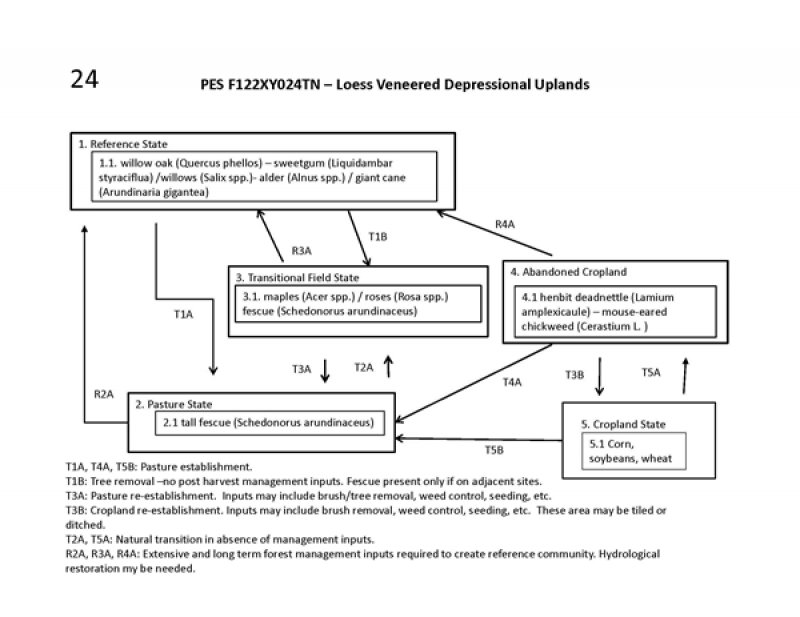
Natural Resources
Conservation Service
Ecological site F122XY024TN
Loess Veneered Depressional Uplands
Last updated: 5/14/2025
Accessed: 12/22/2025
General information
Provisional. A provisional ecological site description has undergone quality control and quality assurance review. It contains a working state and transition model and enough information to identify the ecological site.
MLRA notes
Major Land Resource Area (MLRA): 122X–Highland Rim and Pennyroyal
MLRA 122 is in Tennessee (47 percent), Kentucky (43 percent), Indiana (7 percent), and Alabama (3 percent). It makes up about 21,530 square miles (55,790 square kilometers).
SOILS:
Many of the soils in this MLRA are Udalfs. The moderately deep to very deep, well drained, clayey soils formed in limestone residuum. They are dominantly in rolling to steep areas of the “Outer Basin” (Mimosa, Braxton, Gladdice, and Hampshire series) and the undulating to hilly areas of the “Inner Basin” (Talbott and Bradyville series). The most agriculturally productive soils are the very deep, well drained, clayey or loamy soils that formed in alluvium and/or loess over alluvium or limestone residuum in nearly level to undulating areas (Armour, Cumberland, Harpeth, Lomond, and Maury series). The less extensive soils generally are moderately well drained to somewhat poorly drained and formed in loamy or clayey alluvium and/or residuum (Byler, Capshaw, Colbert, and Tupelo series). This MLRA has a significant acreage of Mollisols. Shallow or moderately deep, well drained, clayey Udolls (Ashwood and Barfield series) formed in limestone residuum dominantly in rolling to steep areas. Very shallow, well drained, clayey Rendolls (Gladeville series) formed in limestone residuum dominantly in undulating to rolling areas of the “Inner Basin.” Very deep, well drained or moderately well drained Udolls (Arrington, Egam, Lynnville, and Staser series) and somewhat poorly drained or poorly drained Aquolls (Agee, Godwin, and Lanton series) formed in loamy or clayey alluvium derived from limestone on flood plains. Most of the remaining soils on flood plains are moderately well drained or well drained Udepts (Lindell and Ocana series). Udults are of small extent in this area. Most are very deep, well drained, and loamy and formed in gravelly colluvium or colluvium and the underlying residuum on steep hillsides (Dellrose soils). Rock outcrops are common on uplands.
BIOLOGICAL RESOURCES:
This area supports mixed oak forest vegetation. White oak, black oak, northern red oak, and some scarlet oak are the dominant tree species. Shagbark hickory, bitternut hickory, pignut hickory, and mockernut hickory also occur. Oak, blackgum, flowering dogwood, sassafras, Virginia pine, pitch pine, and shortleaf pine grow mostly on ridgetops.
(Excerpt from United States Department of Agriculture, Natural Resources Conservation Service. 2006. Land Resource Regions and Major Land Resource Areas of the United States, the Caribbean, and the Pacific Basin. U.S. Department of Agriculture Handbook 296.)
Classification relationships
Central Interior Highlands and Appalachian Sinkhole and Depression Pond (CES202.018)
Ecological site concept
The communities described in this provisional document reflect plant communities that are likely to be found on these soils and have not been field verified. This PES describes hypotheses based on available data and has not been developed utilizing ecological field monitoring and does not encompass the entire complexity or diversity of these sites. Field studies would be required for detailed conservation planning or to develop a comprehensive and science-based restoration plan.
24-Loess Veneered Depressional Uplands
thermic
MLRA 122
Mapunits included in this initial PES grouping include: Dekoven, Guthrie, and Taft.
Future ESD development may result in mapunits being added or removed from this preliminary grouping.
State 1. Phase 1.1.
willow oak (Quercus phellos) – sweetgum (Liquidambar styraciflua) / willows (Salix spp.)- alder (Alnus spp.) / giant cane (Arundinaria gigantea)
State: 2. Pasture
Phase 2.1: Managed Pasture. Plant species dominants: Schedonorus arundinaceus (tall fescue)
Many other species of grass, both warm and cool season, are available for these sites.
State: 3 – Transitional (Abandoned Field)
Phases 3.1: Plant species dominants: Juniperus virginiana/ Rubus spp. - Rosa multiflora/ Vernonia gigantea -Schedonorus arundinaceus
Eastern red cedar /blackberry – multiflora rose/ ironweed- tall fescue
State 4: Phase 4.1. Abandoned Croplands
Plant species dominant:
henbit deadnettle (Lamium amplexicaule) – mouse-eared chickweed (Cerastium L. )
State 5: Phase 5.1. Cropland
Dependent upon seeding and management. Most common crops are corn and soybeans.
It would require years of management, plantings, and weed control to successfully transition to a reference community. Hydrology may also need to be restored if the site has been ditched or tiled.
Associated sites
| F122XY023TN |
Loess Veneered Thermic Uplands Loess Veneered Thermic Uplands |
|---|
Similar sites
| F122XY023TN |
Loess Veneered Thermic Uplands Loess Veneered Thermic Uplands |
|---|
Table 1. Dominant plant species
| Tree |
(1) Quercus phellos |
|---|---|
| Shrub |
(1) Salix |
| Herbaceous |
(1) Arundinaria gigantea |
Click on box and path labels to scroll to the respective text.
